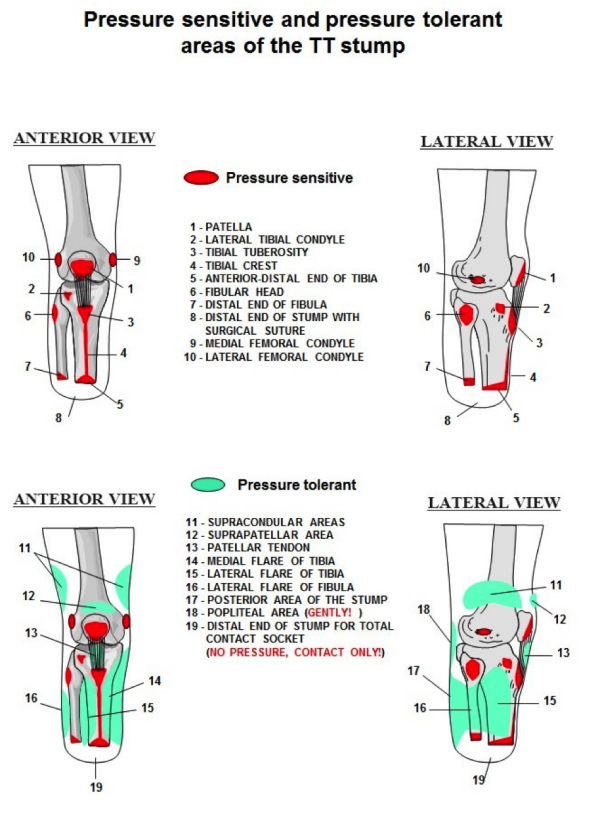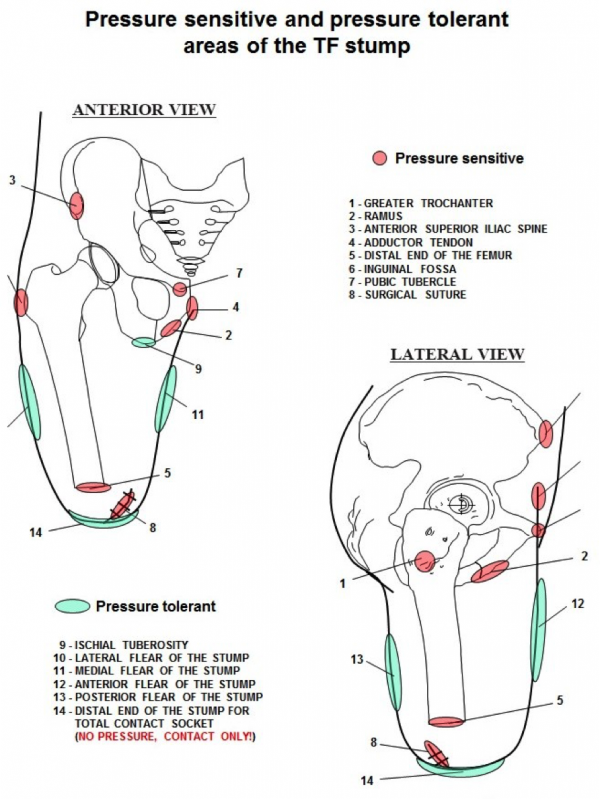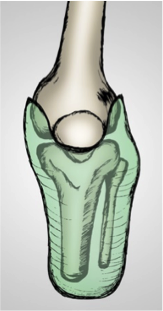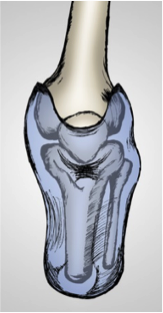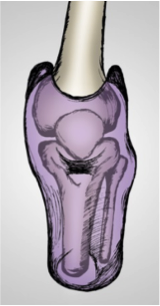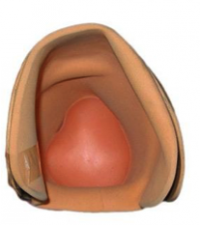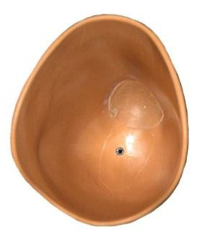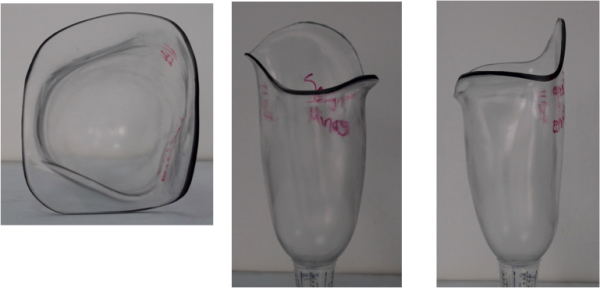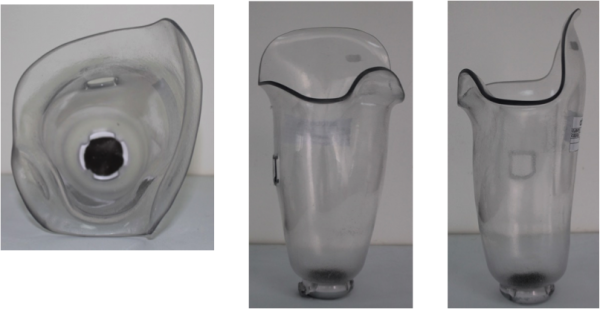Lower Limb Prosthetic Sockets and Suspension Systems
Original Editor - Tarina van der Stockt Top Contributors - Tarina van der Stockt, Kim Jackson, Tony Lowe, Simisola Ajeyalemi and Jess Bell
Socket Casting, Positive Mould, and Rectification[edit | edit source]
The prosthetic socket is the primary interface between the amputee's residual limb and the ground and therefore a good, comfortable fit is required to ensure a positive outcome is reached in an amputees rehabilitation[1].
The prosthetist takes the measurements for the socket using plaster bandages to create a cast (Casting). The cast created is filled with plaster powder to create a positive mould (Positive Mould). The positive mould is then modified to optimize the socket fit, this process is called “rectification” (Rectification). The socket is then shaped over the mold to create the custom socket, this is referred to as a laminated socket. A “check”/diagnostic socket is sometimes fabricated before creating the definitive socket (this socket is usually transparent, allowing the clinician a complete view to evaluate the fit and make changes). Multiple fittings are at times necessary to assure the best possible design with a comfortable and effective fit. Generally sockets are made out of plastic, either thermoplastic or with thermosetting, called laminated sockets. Laminated sockets can be reinforced with fibre glass, carbon fibre, or nylon[2].
Because it is the interface between the device and residual limb, the quality of the socket design, whatever the model used, is key and decides on user’s comfort and his/her ability to control the appliance. A user will never walk properly and will never reach the agreed goal of the rehabilitation plan if the quality of the socket fit is not satisfactory regardless of the material used (plastic, resin or carbon). The quality of the fit depends entirely on the work of the prosthetist and his/her capacity to insure precise measurements during casting and suitable rectification of the positive mould to distribute forces over the socket where needed.
Other methods:[edit | edit source]
- Polypropylene technology developed by the International Committee of the Red Cross (ICRC) is used in prosthetics all over the world, especially in resource-limited countries and projects by the ICRC.
- The Modular Socket System developed by Ossur can be used to make a socket directly on the patient's residual limb. It is an easier and quicker process but the cost is higher. Delivery time to the patient could be within one day. [5]
- A more sophisticated and expensive technique utilized today is a CAD system (Computer Aided Design). With the improvement of technology 3D printed sockets are also gaining momentum.
Pressure tolerant and pressure sensitive areas:[edit | edit source]
The prosthesis applies forces over the body. The amount, the location of their application and the means that control those forces contributes to the impact the prosthesis has on mobility, function, and acceptance of the device. Pressure distribution over a greater surface diminishes the load and provides more comfort during the use of prosthesis.
Although the majority of the stump areas are considered as pressure tolerant, some are very sensitive and cannot support any pressure.
Attention:
Very short TT stumps (shorter than 20% of the anatomical length) are insufficient for providing adequate control over the prosthesis and supporting the body weight. Nevertheless, the quality of the stump is more important than its length.
It is obvious that to be able to fit the stump into the prosthesis: taking into consideration all those preconditions mentioned before, it will be necessary to count on the principal element of the prosthesis – the socket. The later serves as an interface between user and device and due to that has to respond to the physical-anatomical demands of the patient, to the mechanical specificities of components and to the biomechanical requirements of the gait.
Below we describe some common TT and TF socket designs.
Transtibial Sockets[edit | edit source]
Patellar Tendon Bearing[edit | edit source]
| Socket PTB (Patellar Tendon Bearing)
The weight bearing takes place below the patella, at the patellar tendon. The suspension is generated by a belt that is tightened around the distal part of the thigh. The tension of that belt limits the blood and lymphatic circulation; moreover, after long term use results in muscle atrophy and other related problems. |
|
| Socket PTB SC (Patellar Tendon Bearing Supracondylar)
The weight bearing takes place below the patella, at the patellar tendon. The suspension is generated at the medial and lateral areas of the femoral condyles. Compared to the PTB socket with belt suspension, this design does not produce problems of blood circulation or atrophy. For the moment, this type is used worldwide as most basic design for prosthetic fitting of medium and long stumps. |
|
| Socket PTB SC SP (Patellar Tendon Bearing Supracondylar Suprapatellar)
The weight bearing takes place below the patella, at the patellar tendon. The suspension is generated at the medial and lateral areas of the femoral condyles and at teh suprapatelar area. This type is indicated for short stumps, as well as in cases of antero-posterior instability in the knee. |
Indications
Primary Amputees - The PTB socket is good for primary amputees as the socket can be modified to accommodate the changes in the residual limb that occur for 12-18 months after the amputation.
- Sensitive Residual Limbs - If the amputee has a particular area of sensitivity on their residuum it is possible in a PTB socket to relieve these areas more easily than in a total surface bearing style socket.
- Bulbous Residual Limbs - The construction of a PTB socket, an inner liner and outer hard socket, allows for build-ups to be applied to the inner liner allowing easier donning and doffing for an amputee with a bulbous residual limb
- Poor Hand Dexterity/ Poor Eyesight/ Hemiparesis - PTB sockets are much easier to don/doff than total surface bearing sockets
Contraindications
- Active amputees can find the PTB trim lines and suspension methods too restrictive, especially with regards to knee flexion.
- Some amputees can find the PTB prosthesis pistons (see pistoning in gait deviations)
- Some amputees cannot tolerate the pressure on their patella tendon required for a PTB prosthesis to work effectively.
Total surface bearing sockets[edit | edit source]
| Socket SSS (Silicon Suction Socket)
The weight bearing takes place all over the stump surface. The suspension is generated by means of tight adhesion/friction between stump and silicon liner that has a pin at its distal part. This pin is installed in a blocking mechanism inside the prosthetic components, or using a suction mechanism, hence insuring the suspension. Indicated for all types of stumps. |
- TSB sockets “uniformly distribute weight over the entire residual limb” which therefore “delivers a minimal skin pressure”[8].
- TSB sockets are volume matched to the residual limb with 100% surface contact during the gait cycle.
- Successful fitting of a TSB socket requires good control of the soft tissues, minimised pressure peaks and distribution of load over the maximum surface area available[9].
Advantages and Indications
- Active amputees benefit from the lower trim lines possible with the TSB style design[8][10] .
- TSB sockets reduce pistoning of the socket (see pistoning in gait deviations) on the residual limb by providing total contact throughout the gait cycle[11]
- Proprioception is increased due to weight bearing over the entire residual limb and good pressure distribution by the socket walls, which in turn enables the amputee to have better balance with eyes open or closed[11]
- Suspension of the TSB socket is also noted to be better than the PTB design as it is integrated in the socket using locking pins or suction[11].
- Due to the entire surface of the residual limb accepting weight in the TSB socket it is believed that these sockets are more comfortable because overall socket pressure is reduced[12].
Disadvantages and Contraindications
- TSB sockets are not suitable for primary amputees due to volume changes in the first 12-18 months post-amputation[13]. For the same reason TSB sockets are also not suitable for amputees undergoing treatments such as dialysis due to volume fluctuation
- Unsuitable for patients with short residual limbs, less then 10cm long, which require higher trim lines for stability around the knee[10].
- Some amputees may experience pain at the distal end of their residual limb due to the way a TSB/HST socket weight bears over the entire limb[13]. Also patients with excessive soft tissue may drop down into a TSB/HST socket too much which will cause pain at the distal end[13]. Amputees with bony spurs are also not suitable for TSB/HST sockets[13].
- Discomfort during knee flexion may result due to the silicon liner bunching up in the popliteal region[14]
- Increased perspiration may result due to the silicon liner, which can lead to irritation of the residual limb[14]
- TSB/HST sockets are not indicated for amputees with visual/sensory disturbances or Hemiparesis as they are more difficult to don/doff than a PTB design[13].
- Amputees with excessive soft tissue may find they get discomfort upon knee flexion due to creasing of the silicon liner[13]
Transversal view shows the differences between the internal shapes of PTB SC v SSS sockets.
| Socket PTB SC | Socket SSS |
Transfemoral Sockets[edit | edit source]
For TF sockets, the designs mostly used at present are the followings.
Quadrilateral Socket[edit | edit source]
The weight bearing takes place at the ischial tuberosity by the means of ischial support at the posterior shelf of the socket. The suspension is provided by negative pressure (suction) that is generated by adequate fitting of the socket over the stump. In some cases, the suction suspension can be complemented by the use of the belts (Silesian, Neopren, etc.).
For the moment, this type of socket is in most use for all types of stumps.
| Transversal view | Medial view | Posterior view |
Ischial Containment Socket[edit | edit source]
The weight bearing takes place all over the surface of the stump without localizing one specific point; hence, generating more comfort, better control over the prosthesis and security for the user. The ischial tuberosity does not suffer from direct, complete and permanent weight bearing. The principal peculiarity of this design, apart of the exact volume determination, is the medial wall/border of the socket that contains the ischial ramus. The suspension is provided by negative pressure (suction) generated by adequate fitting of the socket over the stump.
For the moment, this type of socket is in worldwide promotion, replacing the quadrilateral one.
Transversal view Medial view Posterior view
| Transversal view | Medial view | Posterior view |
References[edit | edit source]
- ↑ Fergason J and Smith D.G (1999) Socket Considerations for the Patient With a Trans-Tibial Amputation Clinical Orthopaedics and Related Research 361 pages76-84
- ↑ Engstrom B, Van de Ven C, editors. Therapy for amputees. Elsevier Health Sciences; 1999
- ↑ AmputeeOT: How a test prosthetic socket is made. Available from: https://youtu.be/zKib_5eDYUo [last accessed 01/01/18]
- ↑ Shriners Prosthetics BK socket lamination. Available from: https://youtu.be/DngKz0CYQLQ [last accessed 01/01/18]
- ↑ Normann E, Olsson A, Brodtkorb TH. Modular socket system versus traditionally laminated socket: a cost analysis. Prosthetics and orthotics international. 2011 Mar 1;35(1):76-80.
- ↑ ICRC PRP Cambodia Battambang's Prosthetic Workshop Transtibial Prosthesis . Available from: https://youtu.be/Oxez1AL34-8 [[last accessed 01/01/18]
- ↑ Össur Presents: Modular Socket System. Available from: https://youtu.be/qx56HY5ephw [[last accessed 01/01/18]
- ↑ 8.0 8.1 Kahle J.T (1999) Conventional and Hydrostatic Transtibial Interface Comparison Journal of Prosthetics and Orthotics 11(4) 85-91
- ↑ Muller M, Staats T.B, Leach M and Fothergill I , Total Surface Bearing Trans-Tibial Socket Design Impression Techniques
- ↑ 10.0 10.1 Söderberg B (2002) Technical Note: A New Trimline Concept for Trans-Tibial Amputation Prosthetic Sockets Prosthetics and Orthotics International 26 159-162
- ↑ 11.0 11.1 11.2 Yiğiter K, Şener G and Bayar K (2002) Comparison of the Effects of Patellar Tendon Bearing and Total Surface Bearing Sockets on Prosthetic Fitting and Rehabilitation Prosthetics and Orthotics International 26 206-212
- ↑ Moo E.K, Osman N.A.A, Pingguan-Murphy B, Wan Abas W.A.B, Spence W.D and Solomonidis S.E (2009) Interface Pressure Profile Analysis for Patella Tendon Bearing Socket and Hydrostatic Socket Acta of Bioengineering and Biomechanics 11(4) 37 – 43
- ↑ 13.0 13.1 13.2 13.3 13.4 13.5 Hachisuka K, Dozono K, Ogata H, Ohmine S, Shitama H, Shinkoda K (1998) Total Surface Bearing Below – Knee Prosthesis: Advantages, Disadvantages and Clinical Implications Archives of Physical Medicine and Rehabilitation 79 783-789
- ↑ 14.0 14.1 Sewell P, Noroozi S, Vinney J and Andrews S (2000) Developments in the Trans-Tibial Prosthetic Socket Fitting Process: A Review of Past and Present Research Prosthetics and Orthotics International 24 97-107
- ↑ Cornerstone Prosthetics and Orthotics. What Are Your Above Knee Amputee Options? Available from: https://youtu.be/nRzIWANwey0
